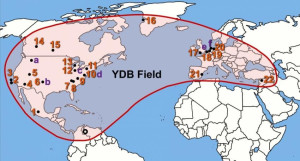Feb 022015

The solid line defines the current known limits of the Younger Dryas Boundary field of cosmic-impact proxies, spanning 50 million square kilometers. Credit: UCSB
They are estimated to have hit the Earth like a blast from a cosmic scatter-gun around 12,800 years ago. This was near the end of the last Ice Age, from which our world had been emerging into a pleasant warming phase, but these impacts set in train a kind of “nuclear winter” and plunged the planet back into a period of deep cold and darkness that lasted until around 11,500 years ago. It is this period of extreme cold that is referred to as the Younger Dryas (after a characteristic Alpine tundra wildflower, Dryas octopetala) but it is only now, with conclusive evidence of the comet impact, that we can be sure what caused it.
For the past seven years academics have been involved in such an intense dispute about whether or not a comet impact actually occurred 12,800 years ago that the implications of what it might have meant for the story of civilization have not yet been considered. But every attempt to refute the impact evidence has in turn been refuted, and the case for the Younger Dryas comet is now so compelling that it is time to widen the debate.
Fingerprint Of A Global Cataclysm
It is clear now that some of the largest fragments of the comet hit the North American ice cap, which was still a mile deep 12,800 years ago, and caused cataclysmic flooding (I had the opportunity to explore some of the extraordinary effects of this on the ground in September 2014 when I drove from Portland, Oregon, to Minneapolis, Minnesota, with catastrophist researcher Randall Carlson).
Simultaneously other large fragments hit the northern European ice cap with the same cataclysmic effects. The result was a global disaster that lasted for 1,300 years. It is, I believe, the “smoking gun” that made us a species with amnesia and wiped out almost all traces of a former high civilization of prehistoric antiquity. But there were survivors, who preserved at least some of the knowledge of the civilization that had been destroyed with the intention of transmitting it to future generations, so it is not an accident that the first traces of the re-emergence of civilization, in the form of the earliest known megalithic architecture and the re-promulgation of agricultural skills, occur at Gobekli Tepe in Turkey 11,500 years ago — a date that coincides exactly with the end of the Younger Dryas and the return to a more congenial global environment.
Everything we have been taught about the origins of civilization occurs after 11,500 years ago — in other words, after the radical punctuation mark of the Younger Dryas. It is what happened before that we desperately need to recover. These are amongst the mysteries that I am exploring in Magicians of the Gods, the book that I have been researching for the past three years and am now in the midst of writing.
About the author:
Graham HGraham Hancock is the author of the major international bestsellers The Sign and The Seal, Fingerprints of the Gods, Heaven’s Mirror and Keeper Of Genesis. His books have sold more than five million copies worldwide and have been translated into 27 languages. His public lectures, radio and TV appearances, including two major TV series for Channel 4 in the UK (Quest For The Lost Civilisation) and The Learning Channel in the US (Flooded Kingdoms of the Ice Age) have put his ideas before audiences of tens of millions. He has become recognized as an unconventional thinker who raises controversial questions about humanity’s past.
In 2002 Hancock published Underworld: Flooded Kingdoms of the Ice Age to great critical acclaim, and hosted the accompanying major TV series. This was the culmination of years of research and on-hand dives at ancient underwater ruins. Arguing that many of the clues to the origin of civilization lay underwater, flooded at the end of the last Ice age, Underworld offered tangible archaeological evidence that myths and legends of ancient floods were not to be dismissed.
Hancock’s most recent ventures include Talisman: Sacred Cities, Secret Faith which explores evidence of the continuation into modern times of a secret astronomical cult, Supernatural: Meetings with The Ancient Teachers of Mankind, an investigation of shamanism and the origins of religion, and his latest book Entangled, a work inspired by his experience of the visionary brew Ayahuasca.
To learn more, visit grahamhancock.com or follow Graham on Facebook.




